Japanese Trains
07 July 2010 14:07 Filed in: Model Trains
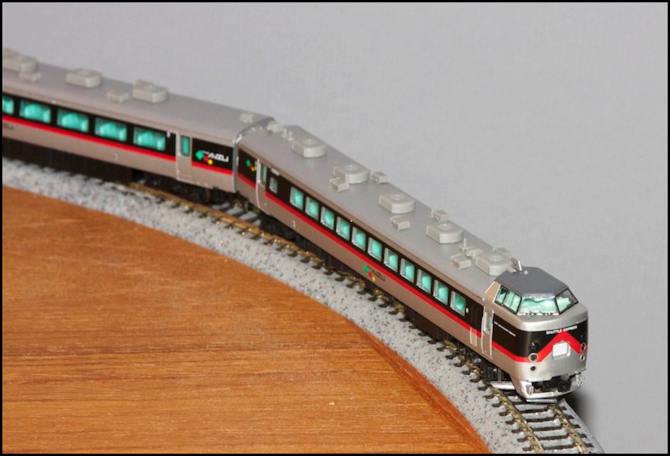
It occurs to me that I’ve been writing about my layout for over six months, and haven’t really mentioned the central reason for it: to run Japanese trains in a setting that evokes their natural urban landscape. In particular, I’m focused on contemporary Japanese passenger trains operated by JR East in and around Tōkyō. That may seem rather narrowly specialized, but Japan has such a variety of passenger trains that it really isn’t.
To provide some focus, I’m (mostly) limiting my collecting to Japan Rail (JR) trains that are or were in service after 2000, and which operate (or operated) into some station in the Tōkyō Metropolitan Area. For passengers this means JR East trains, plus a few JR West Shinkansen (bullet trains). And for freight it means JR Freight, which owns some of its own lines, but largely operates using trackage rights over the rails of other JR companies, putting it clearly secondary to passenger service. There are also a few light rail “tram” lines in Japan, although subways are heavy-rail, and capable of interoperating with the commuter lines in some cases.
One of the things that attracted me to collecting Japanese trains is their variation. As you can see from my Roster page, I now have 17 passenger trains, two articulated trams, and three freight locomotives, and very little repetition (well, I do have E231/E233/E531 trains that look similar, but only two identical Yamanote E231-500 trains). That’s reflective of JR East’s trains in general: the bulk of Tōkyō’s commuter/suburban service is performed by E231/E233 trainsets (over 8,000 cars of them), which replaced the 205 series, and which will eventually be supplanted by the E331 and its relatives. These run in sets of ten to fifteen cars in the city, but many subdivide into smaller four, five or six-car trains in suburban areas. Older trains are often just shuffled off to lesser lines in reduced sizes (many 205 series trains remain in use, some in sets of as little as three cars).
These trains are all 1067mm (3’ 6”) gauge, powered by 1500 Volt DC from overhead lines, even on tracks far from the city. Some subway lines use third-rail, but most of them use 1500 V DC overhead wire. High-voltage AC is used mainly in the Shinkansen lines, although there is some in use on narrow gauge track north of Tōkyō.
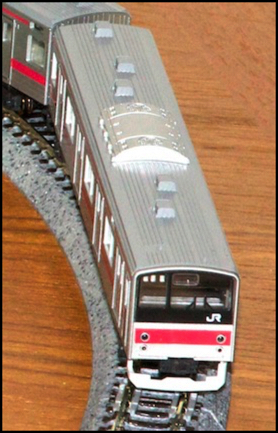
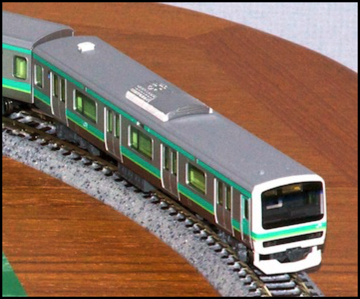
205 Series (left) and E233 (right)
The real variation comes in the “limited express” trains. These are trains that service specialized routes, often to resort areas. They may be unique trainsets, or built in limited numbers, and are typically named. Many of these are built on the older 183/185/189 DC and 483/485/489 AC/DC stock, dating from c. 1968 - 1972. The photo at the top of this column is a 485-1000 in use as of 2001 as the “Viva Aizu” train, serving the Aizu area north of Tōkyō. Other notable expresses include the “Fresh Hitachi”, serving the Hitachi area north of Tōkyō, and the “Super View Odoriko”, serving the resort area of the Izu peninsula, southwest of Tōkyō. These trains tend to be smaller, often six or seven cars long.
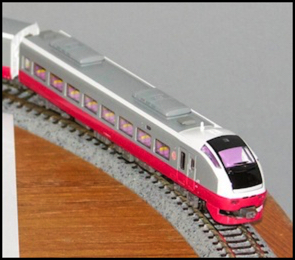
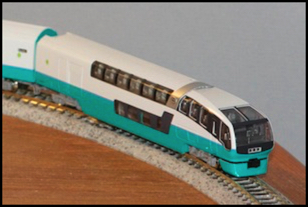
E653 “Fresh Hitachi” (left) and Series 251 “Super View Odoriko” (right)
Although less interesting to me, the Shinkansen (literally “new trunk line”) trains, more commonly known in the west as “bullet trains”, also have considerable variation. The Shinkansen lines use “Standard” gauge track (4’ 8.5”, or 1435mm) and are powered by high voltage AC (either 20 or 25 kV). The Tōkaidō Shinkansen line enters Tōkyō from the south-west, terminating at Tōkyō Station. The Tōhoku, Jōetsu and Nagano Shinkansen lines enter Tōkyō from the north (and northwest), terminating at Ueno Station, just north of Tōkyō Station. Both sets of lines use distinct types of trains, and both are presently evolving to replace older-generation trains with newer ones. Frankly, I don’t particularly like the newer ones, and don’t have any models of them as a result. The new trains sport a duckbill look (see the N700 for an example) to help reduce “tunnel boom”, a sonic-boom like shockwave produced by high speed trains entering the many narrow tunnels of the Shinkansen lines. I prefer the wedge shape of the older trains.
The 500 Series, one of my favorites, was actually produced in only limited numbers, and used for a short time on the fastest series of Tōkaidō line trains operated by JR West into Tōkyō. Recently it has been demoted to a lesser use far from the city. The E3 represents a “mini-Shinkansen” design used on older lines converted to standard gauge and AC power (in this case, the Akita Shinkansen line north of Tōkyō). Such trains operate into Tōkyō coupled to other trains (of which I don’t have an example at present).
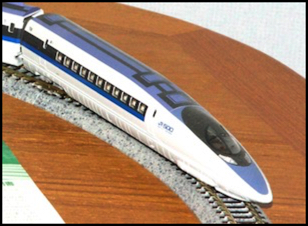
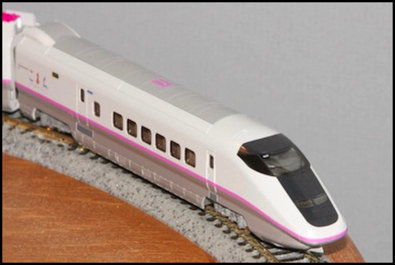
JR West 500 Series (left) and JR East E3 Shinkansen (right)
One class of train that I don’t presently have represented is the locomotive-hauled passenger train. These are still in use for longer-distance intercity trains (on the same narrow-gauge tracks as urban/suburban trains), and some of these include sleeper cars for overnight service. This is a dwindling segment, as more and more of such customers are either using cars or planes, or are served by expansions of the Shinkansen lines. But it’s not gone yet, and eventually I’ll add at least one train of this kind.
Finally, I’ll mention my Tram line trains briefly. The Tōkyū Corporation operates (among other things) one of the last 1372mm (4’ 6”) light rail lines in Japan (and one of only two in Tōkyō; the other is the Toden Arakawa line). At one time this gauge was much more common among urban trains, but over time it was supplanted by the 1067mm (3’ 6”) gauge used by commuter trains. Tōkyū’s Setagaya line operates largely along double-track private right-of-way (with a small amount of track in a road median), using platform stations, so it’s not much like typical street-running trolley lines. Starting in 1999 (some sources say 1997, but the later date appears correct) new two-car articulated sets of 300 Series trams began replacing older stock. I have two of these, which will be limited to a separate “tram line” track (not because I couldn’t run them on my main tracks, but simply because that wouldn’t be at all prototypical).
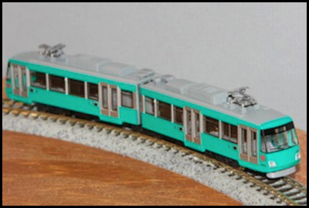
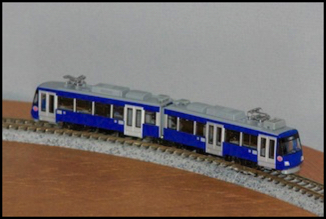
Tōkyū 300 Series Articulated Trams
For more information about Tōkyō-area trains see my Urban, Suburban, Limited Express, and JR East Shinkansen and Other Shinkansen pages. For more information about my trains, see my Roster page, and the subordinate pages linked from it.
There’s a lot more to Japanese trains than what I’ve covered here. Many parts of the country are rural, and often served by short Diesel Multiple Unit (DMU) trains, or even single cars. And in addition to the JR companies, many private operators (some of them quite large) exist. There are even a few steam trains still operating (for “nostalgic” passenger service).
If you’re interested in getting into Japanese trains, I recommend reading up on them at the JNS Forum and asking questions there. They are a knowledgeable and helpful group, and I’ve learned a lot from them. One of the first things to know is that many models are limited runs, and sell out quickly (sometimes during the reservation period preceding the actual release) and aren’t quickly (if ever) re-released. You’ll need to buy from a hobby store with Japanese connections (fortunately there’s a list of these on the JNS Forum) and keep an eye out for advance reservations for things you are interested in. I do most of my train purchases through Hobby Search due to this, although buildings and scenic materials I largely get from local hobby stores. Kato does release a few of their Japanese-prototype trains in the U.S. from time to time, but that is erratic.
One final note on collecting Japanese trains: if you’re thinking about doing it as an investment, don’t. Newer models are almost always better than older ones, and resale value even on the more obscure ones isn’t likely to appreciate much, if at all. Mostly it goes down.
I’ll cover freight some other day. I don’t have much, but do expect to operate the occasional freight train through my passenger layout. Mixed use is typical of Japan’s commuter/suburban lines, only the Shinkansen lines and a few city-center commuter lines are dedicated passenger-only lines.




